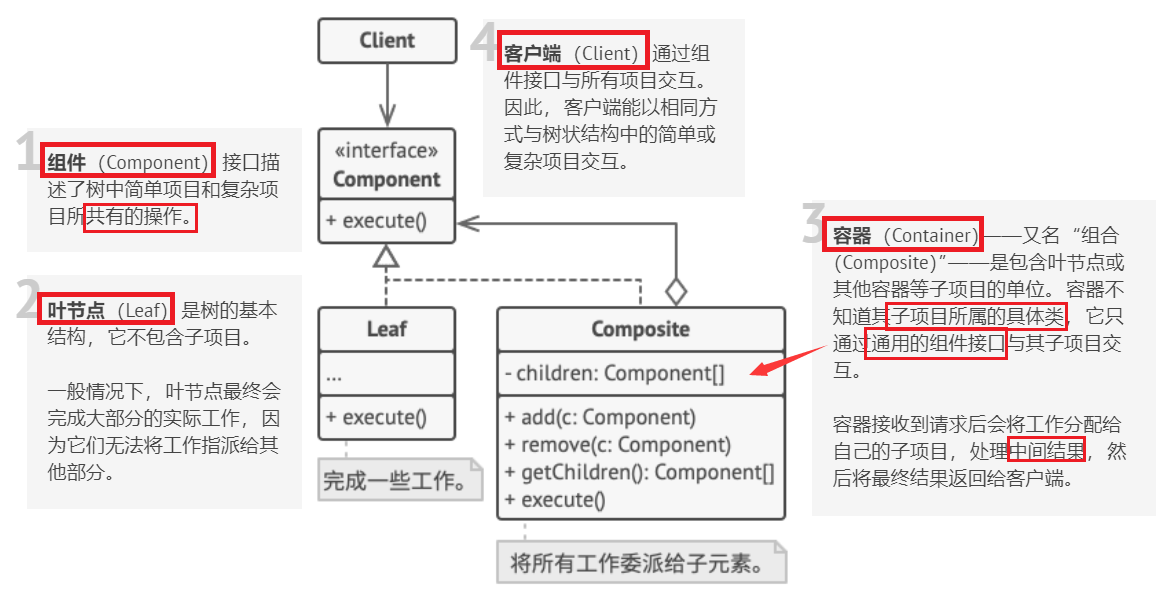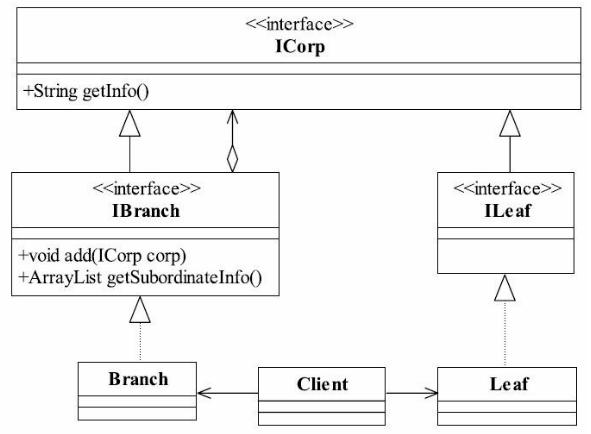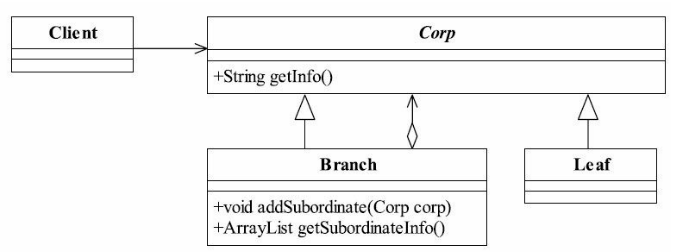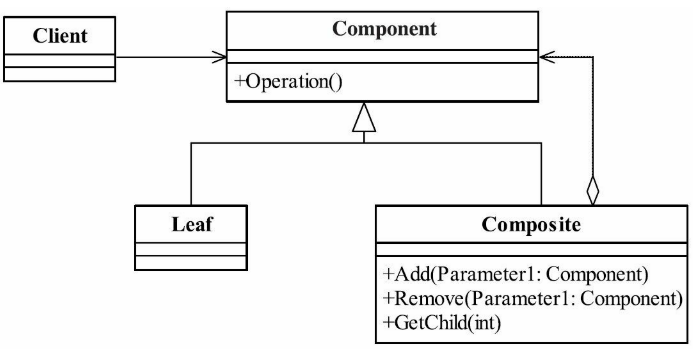

1. 「引例」
- 举例:公司成员结构:总经理->研发部经历->员工。即 根节点->树枝节点->树叶节点。

「根节点接口」
public interface IRoot {// 得到总经理的信息public String getInfo();// 总经理下边要有小兵,那要能增加小兵,比如研发部总经理,这是个树枝节点public void add(IBranch branch);// 那要能增加树叶节点public void add(ILeaf leaf);// 既然能增加,那还要能够遍历,不可能总经理不知道他手下有哪些人public ArrayList getSubordinateInfo();}
「根节点实现」
public class Root implements IRoot {//保存根节点下的树枝节点和树叶节点,Subordinate的意思是下级private ArrayList subordinateList = new ArrayList();// 根节点的名称private String name = "";// 根节点的职位private String position = "";// 根节点的薪水private int salary = 0;// 通过构造函数传递进来总经理的信息public Root(String name, String position, int salary) {this.name = name;this.position = position;this.salary = salary;}//增加树枝节点public void add(IBranch branch) {this.subordinateList.add(branch);}//增加叶子节点,比如秘书,直接隶属于总经理public void add(ILeaf leaf) {this.subordinateList.add(leaf);}//得到自己的信息public String getInfo() {String info = "";info = "名称:" + this.name;info = info + "\t职位:" + this.position;info = info + "\t薪水: " + this.salary;return info;}//得到下级的信息public ArrayList getSubordinateInfo() {return this.subordinateList;}}
「其他含分支节点接口」
public interface IBranch {//获得信息public String getInfo();// 增加数据节点,例如研发部下设的研发一组public void add(IBranch branch);// 增加叶子节点public void add(ILeaf leaf);// 获得下级信息public ArrayList getSubordinateInfo();}
「分支实现」
public class Branch implements IBranch {//存储子节点的信息private ArrayList subordinateList = new ArrayList();// 树枝节点的名称private String name = "";// 树枝节点的职位private String position = "";// 树枝节点的薪水private int salary = 0;// 通过构造函数传递树枝节点的参数public Branch(String name, String position, int salary) {this.name = name;this.position = position;this.salary = salary;}//增加一个子树枝节点public void add(IBranch branch) {this.subordinateList.add(branch);}//增加一个叶子节点public void add(ILeaf leaf) {this.subordinateList.add(leaf);}//获得自己树枝节点的信息public String getInfo() {String info = "";info = "名称:" + this.name;info = info + "\t职位:" + this.position;info = info + "\t薪水:" + this.salary;return info;}//获得下级的信息public ArrayList getSubordinateInfo() {return this.subordinateList;}}
「叶子接口」
public interface ILeaf {//获得自己的信息public String getInfo();}
「叶子实现」
public class Leaf implements ILeaf {// 叶子叫什么名字private String name = "";// 叶子的职位private String position = "";// 叶子的薪水private int salary = 0;// 通过构造函数传递信息public Leaf(String name, String position, int salary) {this.name = name;this.position = position;this.salary = salary;}//最小的小兵只能获得自己的信息了public String getInfo() {String info = "";info = "名称:" + this.name;info = info + "\t职位:" + this.position;info = info + "\t薪水:" + this.salary;return info;}}
测试太长了,就是测试上述的程序,可自行去git仓库上看。唯一要说的是打印下属的信息,需要递归打印
//遍历所有的树枝节点,打印出信息private static String getAllSubordinateInfo(ArrayList subordinateList) {int length = subordinateList.size();for (int m = 0; m < length; m++) { //定义一个ArrayList长度,不要在for循环中每次计算Object s = subordinateList.get(m);if (s instanceof Leaf) { //是个叶子节点,也就是员工ILeaf employee = (ILeaf) s;System.out.println(((Leaf) s).getInfo());} else {IBranch branch = (IBranch) s;System.out.println(branch.getInfo());//再递归调用getAllSubordinateInfo(branch.getSubordinateInfo());}}return null;}
现在需要解决问题。
getInfo每个接口都有,可以抽象出来。- Root类Branch类可以合并,因为根节点本身就是树枝节点的一种。

- 增加一个
ICorp接口,是全公司人员信息接口类,大家都可以获取信息。 这里的
ILeaf是空接口,这里的意义何在?系统扩容时就会体现它的作用!「公司人员接口」
public interface ICorp {// 每个员工都有信息public String getInfo();}
「树叶接口」
public interface ILeaf extends ICorp{}
「树叶实现」
public class Leaf implements ILeaf {//小兵也有名称private String name = "";//小兵也有职位private String position = "";//小兵也有薪水,否则谁给你干private int salary = 0;//通过一个构造函数传递小兵的信息public Leaf(String name, String position, int salary) {this.name = name;this.position = position;this.salary = salary;}//获得小兵的信息public String getInfo() {String info = "";info = "姓名:" + this.name;info = info + "\t职位:" + this.position;info = info + "\t薪水:" + this.salary;return info;}}
「树枝接口」
public interface IBranch extends ICorp{//能够增加小兵(树叶节点)或者是经理(树枝节点)public void addSubordinate(ICorp corp);//能够获得下属的信息public ArrayList<ICorp> getSubordinate();}
「树枝实现」
public class Branch implements IBranch {//领导也是人,也有名字private String name = "";//领导和领导不同,也是职位区别private String position = "";//领导也是拿薪水的private int salary = 0;//领导下边有那些下级领导和小兵ArrayList<ICorp> subordinateList = new ArrayList<ICorp>();//通过构造函数传递领导的信息public Branch(String name, String position, int salary) {this.name = name;this.position = position;this.salary = salary;}//增加一个下属,可能是小头目,也可能是个小兵public void addSubordinate(ICorp corp) {this.subordinateList.add(corp);}//我有哪些下属public ArrayList<ICorp> getSubordinate() {return this.subordinateList;}//领导也是人,他也有信息public String getInfo() {String info = "";info = "姓名:" + this.name;info = info + "\t职位:" + this.position;info = info + "\t薪水:" + this.salary;return info;}}
再进一步优化,
Leaf和Branch都有getInfo方法,抽象出来

接口没了,改成抽象类。IBranch接口没了。方法都在实现类中,场景类只认定抽象类Corp。
「抽象公司职员类」
public abstract class Corp {//公司每个人都有名称private String name = "";//公司每个人都职位private String position = "";//公司每个人都有薪水private int salary = 0;/*** 通过接口的方式传递,我们改变一下习惯,传递进来的参数名以下划线开始* 这个在一些开源项目中非常常见,一般构造函数都是定义的*/public Corp(String _name, String _position, int _salary) {this.name = _name;this.position = _position;this.salary = _salary;}//获得员工信息public String getInfo() {String info = "";info = "姓名:" + this.name;info = info + "\t职位:" + this.position;info = info + "\t薪水:" + this.salary;return info;}}
「树叶节点」
public class Leaf extends Corp {//就写一个构造函数,这个是必须的public Leaf(String _name, String _position, int _salary) {super(_name, _position, _salary);}}
「树枝节点」
public class Branch extends Corp {//领导下边有那些下级领导和小兵ArrayList<Corp> subordinateList = new ArrayList<Corp>();//构造函数是必须的public Branch(String _name, String _position, int _salary) {super(_name, _position, _salary);}//增加一个下属,可能是小头目,也可能是个小兵public void addSubordinate(Corp corp) {this.subordinateList.add(corp);}//有哪些下属public ArrayList<Corp> getSubordinate() {return this.subordinateList;}}
2. 「定义」
Compose objects into tree structures to represent part-whole hierarchies.Composite lets clients treat individual objects and compositions of objects uniformly.
- 将对象组合成树形结构以表 示“部分-整体”的层次结构,使得用户对单个对象和组合对象的使用具有一致性
通用类图 -
-
- Component抽象构件角色
- 定义参加组合对象的共有方法和属性,可以定义一些默认的行为或属性,比如例子 中的getInfo就封装到了抽象类中。
- Leaf叶子构件
- 叶子对象,其下再也没有其他的分支,也就是遍历的最小单位。
- Composite树枝构件
- 树枝对象,它的作用是组合树枝节点和叶子节点形成一个树形结构。
public abstract class Component {//个体和整体都具有的共享public void doSomething() {//编写业务逻辑}}public class Composite extends Component {//构件容器private ArrayList<Component> componentArrayList = new ArrayList<Component>();//增加一个叶子构件或树枝构件public void add(Component component) {this.componentArrayList.add(component);}//删除一个叶子构件或树枝构件public void remove(Component component) {this.componentArrayList.remove(component);}//获得分支下的所有叶子构件和树枝构件public ArrayList<Component> getChildren() {return this.componentArrayList;}}public class Leaf extends Component{/* 可以覆写父类方法 public void doSomething() */}public class Client {public static void main(String[] args) {//创建一个根节点Composite root = new Composite();root.doSomething();//创建一个树枝构件Composite branch = new Composite();//创建一个叶子节点Leaf leaf = new Leaf();//建立整体root.add(branch);branch.add(leaf);}//通过递归遍历树public static void display(Composite root) {for (Component c : root.getChildren()) {if (c instanceof Leaf) { //叶子节点c.doSomething();} else { //树枝节点display((Composite) c);}}}}
3. 「应用」
1. 「优点」
- 高层模块调用简单
- 一棵树形机构中的所有节点都是
Component,局部和整体对调用者来说没有任何区别 - 也就是说,高层模块不必关心自己处理的是单个对象还是整个组合结构,简化高层模块的代码。
- 一棵树形机构中的所有节点都是
节点自由增加
维护和展示部分-整体关系的场景,如树形菜单、文件和文件夹管理。
- 从一个整体中能够独立出部分模块或功能的场景。
4. 「注意事项」
📌只要是树形结构,就要考虑使用组合模式,这个一定要记住,只要是要体现局部和整体的关系的时候,而且这种关系还可能比较深,考虑一下组合模式吧。

